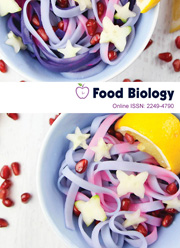Nutritional profiling and value addition of products from Hypsizygus tessellatus
DOI:
https://doi.org/10.19071/fbiol.2017.v6.3139Abstract
Hypsizygus tessellatus is a popular wild edible culinary mushroom commonly cultivated in Japan, East Asia and North Europe. It is rich in micro nutrients and has great anti-tumorous, anti-cancerous rich polysaccharide fractions i.e. β-glucan, thus making it a good source of nutraceuticals. The present study was undertaken to investigate the nutritional as well as medicinal profile of this mushroom. Freeze dried and hot air dried samples were taken for the analysis. HPLC-RID investigations were carried out to estimate the content of β-glucan. The results revealed that it contains high proportions of protein (33.89g/100g), fiber (13.20g/100g), carbohydrates (50.10g/100g), potassium (1575mg/100g), calcium (98mg/100g) and phosphorus (568mg100g). The fat content was found to be 2.80gm/100g. Iron (18mg/100g) and zinc (5mg/100g) were present in trace amounts. Freeze dried fruit bodies showed better results than hot air dried samples pertaining to all nutritional and nutraceutical parameters. Value added products i.e. biscuits and salted crackers were made by incorporating 5 and 10% mushroom powder in refined wheat flour and their proximate, organoleptic and bioactive constituents were analyzed. Sensory evaluation based on hedonic scale resulted in high sensory ratings of all the products. The present study suggested that incorporation of 5% mushroom powder in salted crackers (Mathri) and 10% in biscuits not only increased concentration of protein, dietary fiber and β-glucan but also improved its flavor, texture and acceptability.
Keywords: Hypsizygus tesellatus; lyophilization; hot air drying; salted cracker; biscuits; β-glucan
Downloads
References
Akavia E, Beharav A, Wasser S.P, Nevo E. Disposal of agro-industrial by-products by organic cultivation of the culinary and medicinal mushroom Hypsizygus marmoreus. W. Manag 2009; 29(5):1622–1627.
AOAC. Official methods of analysis, Fourteenth edition. Washington, DC (2000).
Barros L, Baptista P, Correia D.M, Casal S, Oliveira B, Ferreira I. C. F. R. Fatty acid and sugar compositions and nutritional value of five wild edible mushrooms from Northeast Portugal. Food Chem 2007; 105(1):140–145.
Bohn J.A, BeMiller, J.N. (1-3)-β-D-Glucans as biological response modifiers: a review of structure-functional activity relationships. Carb .Poly 1995; 28: 3–14.
Chen J, Lai P, Shen H, Zhen H, Fang R. Effect of extraction methods on polysaccharide of Clitocybe maxima stipe. Adv. J. of Food Sci. and Tech 2013; 5(3): 370–373.
DMR bulletin, Post Harvest Technology of Mushrooms, Solan; 2008.
Eneche E.H. Biscuit-making potential of millet/pigeon pea flour blends. Pl. Foods for Hu. Nutr 1999; 54(1): 21–27.
Hooda S, Jood S. Organoleptic and nutritional evaluation of wheat biscuits supplemented with untreated and treated fenugreek flour. Food Chem 2005; 90: 427-435.
Kang M. G, Kim Y. H, Bolormaa Z, Kim M.K, Seo G.S, Lee J.S, Characterization of an antihypertensive angiotensin I-converting enzyme inhibitory peptide from the edible mushroom Hypsizygus marmoreus. Bio Med. Res Intr 2013; 1-5.
Kumar A, Singh M, Singh G. Effect of different pretreatments on the quality of mushrooms during solar drying. J. of Food Sci. and Techn 2013; 50(1): 165–170.
Mallikarjuna S. E, Ranjini A, Devendra, Haware J, Vijayalakshmi M. R, Shashirekha M. N and Rajarathnam S. Mineral composition of four edible mushrooms. J. of Chem 2013; 1-5.
Mori K, Kobayash C, Tomita T, Inatomi S, and Ikeda M. Antiatherosclerotic effect of the edible mushrooms Pleurotus eryngii (Eringi), Grifola frondosa (Maitake), and Hypsizygus marmoreus (Bunashimeji) in apolipoprotein E-deficient mice. Nutr. Res 2008; 28(5): 335–342.
Okwulehie I.C, Ogoke J. Bioactive, nutritional and heavy metal constituents of some edible mushrooms found in Abia State of Nigeria. Intr. J. of Appl. Micro. Biotech.
Res. 2013; 1: 7–15.
Oliveira L. D. C, M. Oliveira, Meneghetti V.L, Mazzutti S, Colla L.M, Elias M.C,
Gutkoski L.C. Effect of drying temperature on quality of beta-glucan in white oat grains. Ciencia E Tecnologia De Alimentos 2012; 32(4): 793–797.
Pardo P, López-Sánchez J.F, Rauret G. Relationship between phosphorus fractionation and major components in sediments using the SMT harmonised extraction procedure. Anal. Bioanal. Chem 2003; 376: 248-254.
Rai R.D, Arumuganathan T. Post harvest technology of mushrooms, National Research Centre for Mushroom, Solan; 2008. p 213.
Ranasalva N, and Visvanathan R. Development of cookies and bread from cooked and fermented pearl millet flour. Afr. J of Food Sci 2014; 8 (6): 330-336.
Singh R, Chauha G.S. Effect of incorporation of defatted soy flour on the quality of biscuits. J. of Food Sci. Tech 1996; 33(4): 355–357.
Toledo R.C.C, Carvalho M.A, Lima L.C.O, Boas E.V.B.V, Dias E.S. Measurement of β-glucan and other nutritional characteristics in distinct strains of Agaricus subrufescens mushrooms. Afr. J. Biotech 2013; 12 (43): 6203-6209.
Wan Rosli W.I, Nurhanan A.R, Aishah M.S. Effect of partial replacement of wheat flour with Oyster mushroom (Pleurotus sajor-caju) powder on nutritional composition and sensory properties of butter biscuit. Sains Mal 2012; 41(12): 1565–1570.
Zhang, W, Niu X, Zhang W, Liu Z, Yuan S. The cultivation of Agaricus bisporus on the spent substrate of Flammulina velutipes. Afr. J. of Agri. Res 2013; 8(38): 4860-4863.



 .
.